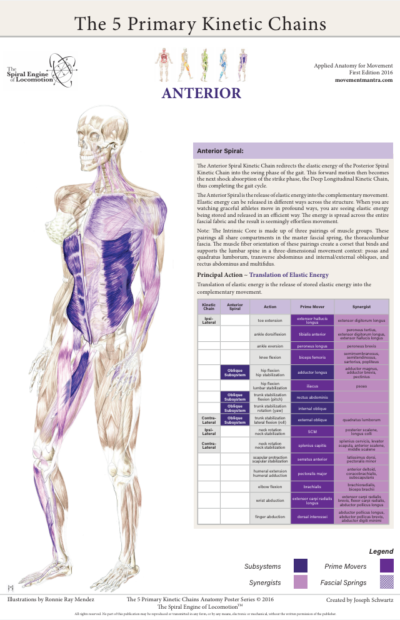
I’d like to talk with you about an anecdotal experience I recently had with a client.
I had a runner come to me who was experiencing knee pain. If I had stopped in my assessment at simply looking at the function of the knee, I would have missed the primary driver of the compensation pattern. Because I linked the relationship of the Anterior Kinetic Chain, and the core cylinder, I was able to correlate an internal oblique issue to the medial knee. It’s not uncommon for ligaments to compensate for the burden when muscular function is impaired. My ability to move beyond the obvious to a deeper level of inquiry – which is what we learn in Dynamic Neuromuscular Assessment™ Seminars – allowed me to get to the more profound root issue for my client.
Anatomy and kinesiology are two disciplines that give clarity to the interdependence of the structure and movement of the body.
Anatomy is the language used to describe the parts. These parts then fit together into systems that synergistically make up the whole organism.
Kinesiology is the language of movement. Through kinesiology, anatomy is given a context. If the language of movement is a symphony, the role of anatomy is to describe the source of each note of music.
Anatomy charts provide the fundamental foundation for understanding the names of bones, joints, ligaments, tendons, muscles, fascia, and so forth – the structure. Kinesiology then defines how each aspect of structure works together to create movement.
One of my teachers, early on in my career, imparted the importance of the breath, movement, and structure as being interdependent.
Movement is a translator to how the structure organizes, movement can’t lie. When the body is experiencing pain, the brain reorganizes movement so that we move around our pain instead of through it. This avoidance is a compensation to keep us in a perceived safe zone. As practitioners, our ability to see deviation in movement is paramount to assisting our clients. Often the walking gait is the lens through which we look during assessment. The 5 Primary Kinetic Chains provide a map of the gait.
The use of color in The 5 Primary Kinetic Chains illustrations imparts upon the teacher/student or practitioner/client, how the body organizes during movement. The kinetic chain charts further define how the body organizes in the optimal manner during gait. Why the gait? The gait is universal to human movement. From birth, our nervous system is prewired for developmental movement with the intention to get us upright and biped. If you have interest in a more in-depth conversation on the walking gait, see my blog on the Master Template. The synergistic organization, or sequential muscular activation, gives context to efficient movement and helps us to identify potential dysfunctional relationships that may not be obvious at first impression to the client or practitioner.
When the synergistic organization of our movement becomes less than optimal, or compensated, the result are over and underworked players. Synergistic dominance is the relationship between these over and under worked players. As a practitioner it is useful to have reference tools – like The 5 Primary Kinetic Chains Poster Set or Desktop Edition to help us dig deeper into the function and dysfunction presented by our clients.
Please leave a comment below about a powerful experience you had either as a client or practitioner where you or they went beyond the obvious to the profound!